tvoptics.tripod.com, HDV camcorder configuration site:JVC gr-hd1, jy-hd10 and Sony hdr-fx1 |
|
|
| Digital Video Formats | Movie equivalent | Resolution in pixels, for digital
video |
Vert. to width |
Scan method |
Pixels/frame |
| NTSC Digital Video, (30 frames/sec) | 8 mm | 480 vert * 720 horiz, odd/even (240*2) | 1 to 1.33 |
interlaced |
345,600 |
| PAL Digital Video, (25 frames/sec) | 8 mm | 576 vert * 720 horiz, odd/even (288*2) | 1 to 1.33 |
interlaced |
414,720 |
| High-Definition 720p, (JVC gr-hd1) | 16 mm | 720 vertical * 1280 horizontal | 1 to 1.77 |
progressive |
921,600 |
| High-Definition 1080i, (Sony hdr-fx1) | 16 mm | 1080 vert * 960 horiz, odd/even (540*2) | 1 to 1.77 |
interlaced |
1,036,800 |
| High-Definition 1080i, standard format | 16 mm at 60 fps equiv | 1080 vert * 1920 horiz, odd/even (540*2) | 1 to 1.77 |
interlaced |
2,073,600 |
| High-Definition 1080p, (24 or 30 fps) | Super 16 mm | 1080 vertical * 1920 horizontal | 1 to 1.77 |
progressive |
2,073,600 |
| Quad High-Definition, (JVC, 30 fps) | 35 mm and beyond | 2160 vertical * 3840 horizontal | 1 to 1.77 |
progressive |
8,294,400 |
The NTSC and PAL television formats originated in the 1930's have been obsolete video recording standards for well over two decades. However the professional HDTV equipment has been bulky and in the $200,000 price range, which dictated the type of commercial productions that could utilize the newer high-definition format. More recently based on an NTT compression chip JVC introduced highly compressed MPEG-2 video recording onto standard, small and low-cost DV tape. Now the 720 by 1280 pixel, progressive scan, format has been adopted by all major camcorder manufacturers, and provides 266% more image information on each frame than NTSC or PAL video, in a progressive format that minimizes the interlaced or alternate scan line artifacts, as well as maintaining the standard (1 to 1.77) wide screen format. While the camera has incorporated many basic features that are fundamental to high-definition recording at a comparatively reasonable price, there are still a number of relevant options that are typically outside of any camcorder's standard configuration, that are significant in terms of optical versatility and sound quality; such as wide-angle and telephoto optics, wireless and studio quality stereo recording, portable lighting, optical filtration, as well as image processing options. An effort has been made here to review the widest range of configuration options available, and select components, consistent with quality, portability and the avoidance of redundancy, or items that offer no significant technical benefit. The hardware configuration listed below is the result, and is provided as a basis for further hardware comparison and testing. Naturally as certain technologies are updated the configuration will predictably change. The next significant change would of course be the availability of 2.1 megapixel per frame video recording (1080 by 1920 pixels in a digital progressive scan format at 30 frames per second); however although immediately technically feasible, that does not appear to be likely any time soon. Although in April of 2004, JVC had announced a significantly larger 1080 by 1920 format camera with an estimated price of $20,000. without lens, using 3 Rockwell HDTV chips (from Camarillo California), which is a significant cost reduction. It's also expected that many of the items listed would simply be transferable to a newer camcorder design when the next generation low-cost HDV format cameras become available. Given the considerable improvements in image quality already available at this point with 720p, this configuration does appear to be a reasonable high-definition standard to adopt; whether for producing DVD's in NTSC or PAL formats, as well as HDTV DVD's, along with streaming or downloadable web video at various resolutions, or perhaps converting to 35 mm motion picture film and digital projection systems. More significantly this appears to be a versatile system that can be configured and fully purchased for less than the equipment rental costs of one day's shooting on a commercial project. Which may mean that for the first time it's the personal vision that needs more attention than the struggle to finance the rental of equipment and the post-production expenses. Of course having something relevant or helpful to be communicated would be useful; not simply the repetition of conventional formulas that dominate Hollywood and most documentaries. For technical reference purposes the following are some video frames from the JVC GR-HD1 recorded in its 720 by 1280 progressive scan mode. (Note: The images are at 100% scale, not reduced, so horizontally scrolling may be needed.)
Please note, if you could come up with a better HDV camera configuration, I will get rid of my equipment and adopt your suggestions. Currently the Sony HDV alternative has some significant problems intentionally imbedded in the camcorder that present some particularly exasperating editing and image processing issues. The configuration mentioned here was assembled in 2003, and it was very clear from the beginning that the configuration had a long list of shortcomings that have not been addressed by camcorder manufactures, or certainly not for less than $200,000 and that high resolution or high quality sound issues will not be considered for perhaps more than a decade. While perhaps any camcorder manufacturer can produce a 3 chip system that records 1080 by 1920 progressive scan that sells for around $3000 apparently that's not likely to happen any time soon, and in the mean time there are no fully satisfactory choices available. Another alternative would be to personally design and build a camcorder if you felt like investing in a team effort.



NOTE: So far, after going to the hd-channel.com link, using the back-arrow does not allow for returning to this site: tvoptics.tripod.com
HDV download site - over 16 useful high-definition video samples ranging between 30 and 90 megabytes if you scroll down at: http://www.hd-channel.com/programme.html
CAMCORDER: In order to make some documentaries I purchased a JVC 720p HDTV camcorder GR-HD1, with a JVC list price of $3500, from Broadway Photo of Brooklyn New York or bwayphoto.com at their price of $2099, plus $141.84 for FedEx air; which included all factory wrapped standard accessories and a USA warranty. I confirmed my Visa card information at 6:30 PM Pacific Time and received the camera at 9 AM the next morning, just over 14 hours later in a small California city. Through various web sites I noticed that buying a camera from some of the low priced dealers, including Broadway Photo, can easily be extremely frustrating or disastrous, so I mentioned the approach taken (in September of 2003).
Yes, Broadway Photo wanted to sell numerous accessories, that I was sure I would never use, however they listened to my comments and they did ask me to listen to their pitch for insurance and accessories; and they never suggested that I post any complements. Compared to the few new car dealers I've met, Broadway Photo was easier to deal with; but obviously whenever you buy anything, you had better know exactly what you are doing including the exact specifications, the list and discount prices of each item you are buying; B&H and Adorama, who have good reputations, were both $2695 plus a small shipping charge, and locally Good Guys was $3495 plus about $300 tax. Earlier I started to buy the camera from Royal Camera (CCI Camera City of Brooklyn NY) for $1879 plus $80 for UPS air, without a US warranty, which I declined; however JVC will do repairs for $90/hour anyway, with typical repairs averaging 1.5 hours, maximum 2 hours, if it was ever needed. Incidentally the US warranty only covers labor for 90 days, parts 1 year; so a gray-market camera could be perfectly reasonable, besides warranty work could be honored in Japan through UPS if it's ever needed, and an English manual is available via e-mail from JVC. However I wouldn't care to try reading Kanji characters on the camera's display, if that were ever a possibility.
After reading the Camera Shop section’s comments at “photo.net” I became extremely concerned about the camera purchase, but I didn't want to pay $600 to $1600 extra either. So yes do: 1) use your Visa or MasterCard, 2) order over the web and save your order confirmation page, 3) immediately fax a letter to the company confirming all details of the order, the model, accessories, warranty, shipping, etc. 4) then call to confirm the order. The order could go well, or may be declined, and if declined so you move on to the next company, and perhaps pay a little more; and if the item shipped is completely wrong then call the credit card company and ship it back.
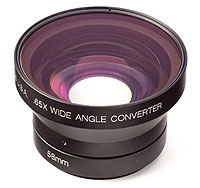 OPTICS:
After an additional month of research I then purchased the optical accessories;
incidentally far fewer companies carried these items. They were purchased from
B&H in New York by phone and with a Visa card, also by my request they immediately
e-mailed an invoice. These items were: 1) Century Optics .65x wide-angle adapter
58mm version (DS65CV58 list $495, B&H $399.95) 52 to 58mm step-up ring included.
2) Century sunshade with 82mm filter holder DS-FA82-00 (list $175, B&H $149.95).
3) Century close-up adapter +2 diopter AD-5820 (List $250, B&H $209.95).
4) Schneider B+W 82mm polarizing filter 65-062142 (BWP82 list $202, B&H
$97.95). 5) Schneider B+W 82mm Skylight KR-1.5 or 1A filter 65-073328 (BWSL82
list $126, B&H $60.50). 6) Tiffen 82mm Neutral Density 3 stop or .9 filter
82ND9 (List $98.42, TIND.982 B&H $42.19).
OPTICS:
After an additional month of research I then purchased the optical accessories;
incidentally far fewer companies carried these items. They were purchased from
B&H in New York by phone and with a Visa card, also by my request they immediately
e-mailed an invoice. These items were: 1) Century Optics .65x wide-angle adapter
58mm version (DS65CV58 list $495, B&H $399.95) 52 to 58mm step-up ring included.
2) Century sunshade with 82mm filter holder DS-FA82-00 (list $175, B&H $149.95).
3) Century close-up adapter +2 diopter AD-5820 (List $250, B&H $209.95).
4) Schneider B+W 82mm polarizing filter 65-062142 (BWP82 list $202, B&H
$97.95). 5) Schneider B+W 82mm Skylight KR-1.5 or 1A filter 65-073328 (BWSL82
list $126, B&H $60.50). 6) Tiffen 82mm Neutral Density 3 stop or .9 filter
82ND9 (List $98.42, TIND.982 B&H $42.19).
Certainly don’t buy anyone’s diffusion filters like “Black Pro-Mist”, there are 8 grades available, and once on tape, these effects cannot be undone; however Magic Bullet will allow adding the desired diffusion later or not at all. I wouldn't consider reshooting the camera work to be a reasonable option when the effects could be done in software.
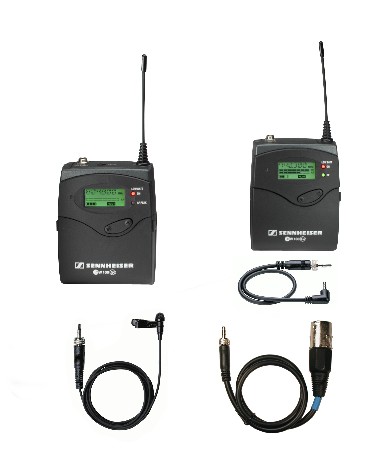 MICROPHONES:
I wanted to improve the sound recording to studio quality, based on some advice
since testing was not particularly feasible; also since a camera records what's
in front of it and background noises need to be reduced, naturally with considerable
directional qualities, however not as large as a shotgun that would create an
unwieldy and intrusive configuration, and so I bought (2) AKG hypercardioid
CK93 microphones (List $201 each, special order items from Guitar Center $125),
which requires (2) SE300B (List $288 each, Guitar Center $190), plus (2) compact
shockmounts by K-Tek, model K-SM direct from K-Tek, mklemme.com (List $135 each,
K-Tek $81), these microphones are connected to the camcorder through a BeachTek
DXA-8 with preamps and balanced phantom power (this unit was acquired from B&H
in 2004 and exchanged with BeachTek since the first unit started generating
crackling sounds). Naturally recording would be much easier if any camcorder
had 2 built-in XLR connectors that provided phantom power to the microphones,
with adequate internal amplification for the external microphones.
MICROPHONES:
I wanted to improve the sound recording to studio quality, based on some advice
since testing was not particularly feasible; also since a camera records what's
in front of it and background noises need to be reduced, naturally with considerable
directional qualities, however not as large as a shotgun that would create an
unwieldy and intrusive configuration, and so I bought (2) AKG hypercardioid
CK93 microphones (List $201 each, special order items from Guitar Center $125),
which requires (2) SE300B (List $288 each, Guitar Center $190), plus (2) compact
shockmounts by K-Tek, model K-SM direct from K-Tek, mklemme.com (List $135 each,
K-Tek $81), these microphones are connected to the camcorder through a BeachTek
DXA-8 with preamps and balanced phantom power (this unit was acquired from B&H
in 2004 and exchanged with BeachTek since the first unit started generating
crackling sounds). Naturally recording would be much easier if any camcorder
had 2 built-in XLR connectors that provided phantom power to the microphones,
with adequate internal amplification for the external microphones.
Recording operation: Typically the sound quality is much better if one channel caries the speakers voice with the wireless mic and the left hypercardioid mic (which further away from the tape drive motor) is on for closer and overall sound; however this means that 4 batteries are being used to operate the system, 1 for the camcorder which is easy to charge and monitor, 1 (9 volt) for the balanced preamps and phantom power, 1 (9 volt) for the transmitter and 1 (9 volt) for the receiver. So it becomes difficult to estimate how much power is remaining in each battery, so monitoring the sound with a headset is essential, and in many situation interrupting the recording is impossible, so loading full capacity batteries is essential, and naturally the cost of batteries can be more than the digital tape or other operating costs. However the sound quality is vastly superior to using the camcorder's internal mics. Unfortunately 9 volt rechargeable batteries carry a small fraction of the capacity of alkaline batteries as well as loose their charge rapidly over a few weeks and so can't be easily stored. A 9 volt Everready alkaline carries 625 mAh capacity while NiMH is 7.2 volt with 150 mAh, which is less than 1/4 the capacity, which would allow for a very short recording time. A larger external 9 volt rechargeable supply could power the preamp and wireless receiver if it were securely packaged; unfortunately the camera provides no external 9 volt outlet.
For a digital wireless clip-on microphone receiver and transmitter with a 300 foot range, the Sennheiser EW112Pc includes an ME2 omni-directional microphone with a list price of $835 and store-pricing ranging from $379 (Rat-Pack Audio) to $499, and $379 price matched at Guitar Center; the frequency range must be selected from sennheiserusa.com web site based on open UHF TV frequencies in any given area to choose the low, medium or high range (a, b, c) prior to ordering; also the MKE2-EW is a high-end omni mic upgrade option which is used by some production companies and lists for $350, or the MKE104 for cardioid and MKE105 for a small super cardioid. However if anyone needs a shotgun microphone, Sennheiser’s ME-66 with its AA battery powered K6 power module has excellent specifications, a very good reputation and reasonable pricing. The camera could be configured with one AKG CK91 omni-directional microphone for at camera pick-up and a wireless Sennheiser EW112Pc or ME-66 shotgun depending on the situation. Given the light above the camcorder, the on camera microphones are probably best mounted below the camera as far forward a possible, to help reduce noise being picked-up from the tape drive motor on the right side of the camcorder, which is also typically a better position for voice pick-up (since sound is not emanated from people’s scalp where most camcorder shotgun microphones are aimed). Consequently a flat aluminum plate attached below the BeachTek preamps extending forward and holding a short horizontal 3/8 inch bolt could attach to the two CK93’s shockmounts on the right and left side of the camcorder, spacing the microphones about 8 inches apart with the pick-ups slightly in front of the lower corners of the lens shade.
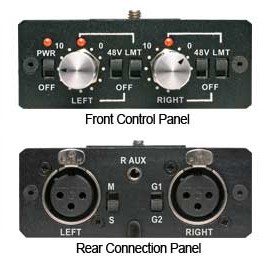 BeachTek
notes: (A) When the DXA-8 is used for an hour or two some odd effects
may occur (in one unit), such as periodic (about every 1 second) clicking or
a complete audio shutdown. Perhaps it’s heat related or a minor component
issue. Shutting it off for a few seconds allowed the DXA-8 to work for a few
seconds longer when it was turned back on. However BeachTek has been very helpful
and knowledgeable regarding diagnosis and warranty replacement of the unit.
When a DXA-8 shuts down, see if a microphone, which doesn’t need power,
can function and the power light is on or off when the power switch is on..
BeachTek
notes: (A) When the DXA-8 is used for an hour or two some odd effects
may occur (in one unit), such as periodic (about every 1 second) clicking or
a complete audio shutdown. Perhaps it’s heat related or a minor component
issue. Shutting it off for a few seconds allowed the DXA-8 to work for a few
seconds longer when it was turned back on. However BeachTek has been very helpful
and knowledgeable regarding diagnosis and warranty replacement of the unit.
When a DXA-8 shuts down, see if a microphone, which doesn’t need power,
can function and the power light is on or off when the power switch is on..
(B) Always use DXA-8’s limiting switches up or on; and in addition preferably
shut-off the camera's internal audio limiting system (which may not be an option
on the JVC GR-HD1), since the DXA-8 is claimed to have a cleaner amplifier and
so it would be best to depend on its +15 db of audio amplification and not the
camera’s, typically.
(C) The AKG CK93+SE300B microphone is considered to have marginal signal strength
without amplification, which is not a big issue nor particularly unusual, that
is it may not be strong enough to pick-up faint sounds through a passive balancing
unit as the DXA-6vu (this was not tested here), so an amplifier like the DXA-8
would help, plus depending on the DXA-8’s amplifiers instead of the camera’s
internal amplifiers should give a cleaner sound quality. The Sennheiser wireless
receiver output is considered a strong signal and would be OK as passive. Incidentally
the potentiometers on the passive units are only used to cut-down on the input’s
amplitude which wouldn't be necessary.
(D) Set DXA-8 potentiometers so that loud sounds cause lights above pots to
flicker to maintain maximum signal to noise.
(E) If phantom power is on and a microphone doesn’t use phantom power
is there any issue? It could create a problem on an unbalanced microphone, or
at best it would waste power, so keep the phantom power switch off if the microphone
doesn’t need it. On a balanced XLR microphone connector pin 1 is ground,
pin 2 and 3 are for audio signal as well as both being for 48 volt power; on
such a connector phantom power on or off wouldn’t cause any harm. However
since the Sennheiser receiver is an unbalanced source, but may have a capacitor
to protect the unit from such a mishap, nevertheless power may still be wasted
if the phantom power switch is on.
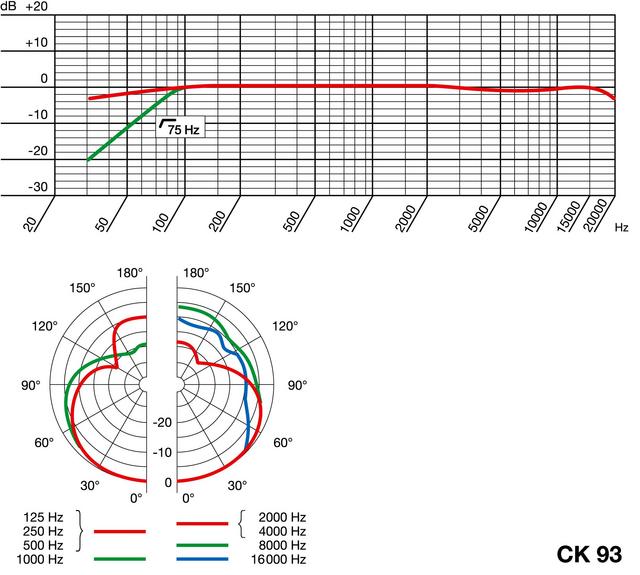
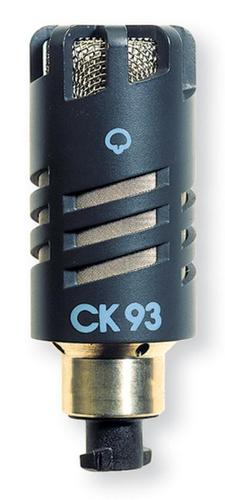
Polar pattern: hypercardioid (CK93, AKG Blue Line)
Frequency range: 20 to 20,000 Hz
Sensitivity: 10 mV/Pa (-40 dBV)
Max. SPL: 132/142 dB (for 1% THD)
Equivalent noise level (CCIR 468-3): 28 dB
Equivalent noise level: 17 dB-A
Signal/noise ratio (A-weighted): 77 dB
Supply voltage: through SE 300 B
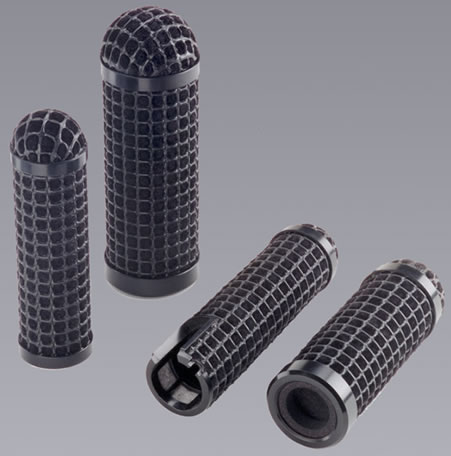
WINDSCREENS: Indoors the foam AKG model W90 (egg shaped 1.7 inch diameter by 2.5 inch) is fine with no notable high-frequency suppression, $12.50 from AKG 615-620-3800 Tenn. However the foam cover can easily brush against a case or clothing and get lost, consequently should be taped to the mic or a small net used to hold the foam in place. Outdoors the foam which covers the 19mm (.7 inch) diameter by 52mm (2 inch) length CK93 capsule, can allow for considerable wind flutter to get recorded. Other fur covered foam windscreens may or may not be a fully adequate solution if a significant wind picks-up, such as the Rycote Softie (with 5cm length & small hole, list $99 Redding Audio 203-270-1808); or the Fat Cat by Remote Audio which goes over the AKG foam $68 list, 615-256-3513 Tenn; $58 Location Sound 818-980-9891; however fully covering a shotgun mic with the Rycote Windshield or Windjammer is considered better. As an alternative, rigid covers which provide dead-air around the mic are recommended such as the Lightwave Miniscreen model MS101 ($140 list) for the CK93 providing (perhaps up to) 20db of wind suppression with little high frequency loss, and so may not need to be removed indoors; however the optional fur Mini-Windmaster cover when not needed for greater winds should be removed to restore the higher frequencies of the audio. The addition of the Mini Sock cover (MSC101 $40 list) will reportedly do little for the Miniscreen; while the Mini Windmaster cover may provide an additional 12db of suppression (MWM101 $90 list) and should allow for working in more severe conditions. The Miniscreen can be used in limited rain and snow, helping keep the microphone dry. The Miniscreen will dampen some impacts to protect the microphone (Redding Audio: 203-270-1808, US distributor CT). To reduce wind noise for the Sennheiser and other small wireless mics, the Lavalier Windjammer in gray, dark-gray and white by Rycote ($26.50 from B&H) provides wind-shielding; and Remote Audio makes the Micro Cat in gray, tan and white $25 list. Unfortunately I could not find any test data for any windscreens, perhaps done in a wind tunnel or with a fan at various distances, showing wind speed and the recorded wind flutter results in decibels for various angles, windscreens and combinations of approaches used; along with the high-frequency losses measured in decibels for several spectrum ranges. There is a curious saying that: Sound is 20% of the production's budget, but 80% of the problems.
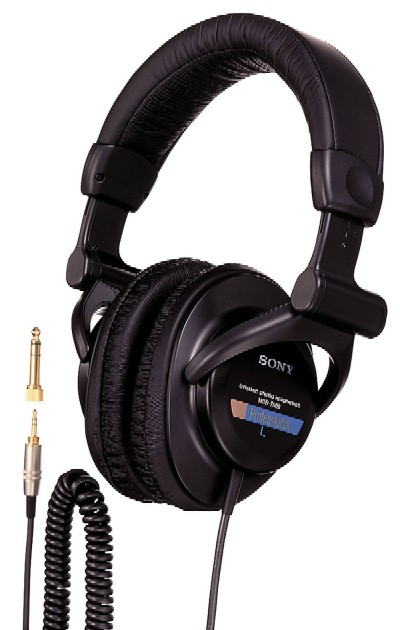
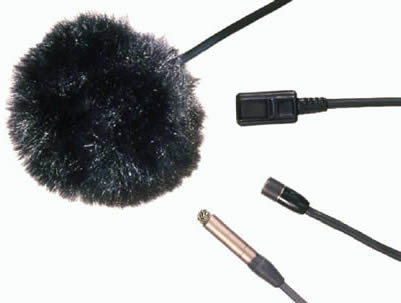
HEADSET: High sound output, that is high efficient for the low-output power from a compact camcorder, as well as compact headset to monitor the camcorder’s audio recording is essential; otherwise hours of useless sound on flawed configurations can get recorded before discovering that a major or even minor technical problem exists. The Sony MDR-7506 or 7509 (sensitivity= 107db/mw, 5 to 30000 hz, list $265), which is a closed earpiece design, so as not to radiate sound from the headset during recording can provide studio quality monitoring anywhere; also include a very low-cost headset such as the Sony MDR-A44L (sensitivity= 108db/mw, 10 to 23000 hz, list $25), which is very small for minimal monitoring and shooting, and can be helpful where more careful monitoring may interfere with overall listening and production work; These other headsets appeared to be too large and not a foldable design and so not convenient for field work: the Sennheiser HD-280, list=$199, although studio monitor quality and comfortable however they stick out at the sides, or AKG’s model K-240;
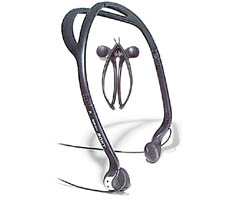
TELEPHONE to XLR: (in research) JK Audio 800-552-8346, jkaudio.com, solutions: THAT-2 handset tap list=$225; Quick Tap for handset list=$59; Inline Patch plugs into any RJ-11 jack has 4 pot controls, but picks-up 60 cycle hum which needs to be filtered-out list=$270; TAP-1 ($245=list) to Innkeeper + mic allows for clear phone reception plus high-quality mic for local speaker, and no 60 cycle hum, a high quality solution.
 RADIO
SCANNER: Yupiteru MVT-9000 EU MK2 receiver, Euro=448.24 ($520.+$25.
FedEx shipping) from: www.bander.com (not available from stores in the US, since
it doesn't block phone frequencies, which are digitally scrambled and so would
not be accessible through such a scanner anyway), this scanner offers full spectrum
531 kHz to 2039 MHz, with modes for: WFM (wide frequency modulation), FM (narrow
FM), NAM (narrow AM), AM, LSB (lower side-band), USB (upper side-band), CW,
in addition to some analog de-scrambling, also this unit is considered to have
excellent sensitivity, however the short antenna that comes with it is considered
almost useless, so a specific antenna designed for the band of interest is recommended;
also a second manual is available from: Rich Wells www.strongsignals.net in
published form or as a free down-load version. When learning, neither manual
is actually clear, so thousands of attempts later simple tasks might be learned
somehow, consequently another manual for beginners would be helpful. So far
I feel lucky to have figured out 5% of the features and just tune in an ordinary
radio broadcast. [Note: Scanners can be very difficult to learn to use, and
others as the AOR AR8200 MK3, also with a load of features can be much more
difficult to use, to the extent that very often the scanners have to be resold.
Some scanners as the ALINCO DJ-X2000E (euro version) which also has good sensitivity
and high scanning speeds, do offer a computer interface for frequency-list down-loading
to the scanner (although not openly supported by ALINCO), nevertheless may be
very helpful and may be a good choice. A hand-held scanner which can be fully
controlled from a windows notebook or palm computer would be a huge benefit
and cost less to manufacture using USB-2 which could provide power from the
computer, provide speakers in the computer and allow for audio recording to
the hard-drive; however the only unit of this type with just one of these features
is available from ICOM and is considered technically a poor choice as a receiver,
and is clearly not a portable.] For lower frequency 11 meter or CB a recommended
car roof or trunk mount antenna is from Wilson 800-541-6116=tech, naturally
it may make sense to avoid having strong magnetic roof mounts in the car, because
when parking if there's any magnetic media or computer in the car it may be
destroyed; so a bolt-on trunk mount may be preferable; even though a centered
roof mount may provide better reception. Radio distributors include: Universal
Radio and Grove Enterprises: grove-ent.com
RADIO
SCANNER: Yupiteru MVT-9000 EU MK2 receiver, Euro=448.24 ($520.+$25.
FedEx shipping) from: www.bander.com (not available from stores in the US, since
it doesn't block phone frequencies, which are digitally scrambled and so would
not be accessible through such a scanner anyway), this scanner offers full spectrum
531 kHz to 2039 MHz, with modes for: WFM (wide frequency modulation), FM (narrow
FM), NAM (narrow AM), AM, LSB (lower side-band), USB (upper side-band), CW,
in addition to some analog de-scrambling, also this unit is considered to have
excellent sensitivity, however the short antenna that comes with it is considered
almost useless, so a specific antenna designed for the band of interest is recommended;
also a second manual is available from: Rich Wells www.strongsignals.net in
published form or as a free down-load version. When learning, neither manual
is actually clear, so thousands of attempts later simple tasks might be learned
somehow, consequently another manual for beginners would be helpful. So far
I feel lucky to have figured out 5% of the features and just tune in an ordinary
radio broadcast. [Note: Scanners can be very difficult to learn to use, and
others as the AOR AR8200 MK3, also with a load of features can be much more
difficult to use, to the extent that very often the scanners have to be resold.
Some scanners as the ALINCO DJ-X2000E (euro version) which also has good sensitivity
and high scanning speeds, do offer a computer interface for frequency-list down-loading
to the scanner (although not openly supported by ALINCO), nevertheless may be
very helpful and may be a good choice. A hand-held scanner which can be fully
controlled from a windows notebook or palm computer would be a huge benefit
and cost less to manufacture using USB-2 which could provide power from the
computer, provide speakers in the computer and allow for audio recording to
the hard-drive; however the only unit of this type with just one of these features
is available from ICOM and is considered technically a poor choice as a receiver,
and is clearly not a portable.] For lower frequency 11 meter or CB a recommended
car roof or trunk mount antenna is from Wilson 800-541-6116=tech, naturally
it may make sense to avoid having strong magnetic roof mounts in the car, because
when parking if there's any magnetic media or computer in the car it may be
destroyed; so a bolt-on trunk mount may be preferable; even though a centered
roof mount may provide better reception. Radio distributors include: Universal
Radio and Grove Enterprises: grove-ent.com
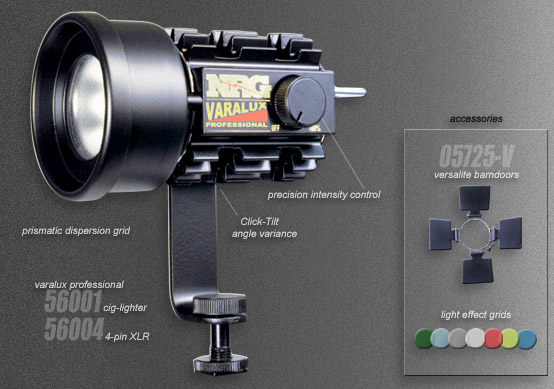 LIGHT:
For portable on camera lighting to supplement natural lighting, reduce video
contrast and fill darker shadows, on the camcorder’s handle with mounting
shoe I'm attaching the pulsed dimmable NRG Varalux Professional light head with
XLR connector, model 56004 (list price $254.95, $219.95 at Express Video Supply);
with 60% interview grid diffuser to assist in taking the sting out of the bulb,
model 05218, (list $24.95, EVS=$21.95) the diffuser grid may help adequately
with a 20 watt bulb but not with a 50 watt bulb, so an additional 8 inch square
white fiberglass sheet diffuser was clipped to the barndoors which reduces all
eye strain greatly but requires perhaps twice the light output; Dichroic daylight
balance grid 3200 to 5600 Kelvin, model 05520 (list $39.95, EVS=$34.95); Barndoors
to hold diffusion material, model 05725-V (list $39.95, EVS=$39.95); Lead acid
battery belt 10 amp-hour, 12 volt, dual 4 pin XLR connectors, 9.5 pound, model
51044 (EVS=$189.95); MR-16 socket bulbs all 12 volt made by ushio.com 800-838-7446
Cypress CA, and diffusion materials all from Star-Lite 624 N Victory Blvd. Burbank
CA, 866-782-7548, 20 watt 60 degree wide angle BAB = $2.95; 35 watt 60 degree
FMW = $3.25; 50 watt 60 degree FNV; 75 watt 60 degree EYC = $2.25; 75 watt spot
EYF = $2.25. (These same bulbs may have a list price of $25 at NRG and sell
for $20 at EVS, and $3 at Star-Lite.)
LIGHT:
For portable on camera lighting to supplement natural lighting, reduce video
contrast and fill darker shadows, on the camcorder’s handle with mounting
shoe I'm attaching the pulsed dimmable NRG Varalux Professional light head with
XLR connector, model 56004 (list price $254.95, $219.95 at Express Video Supply);
with 60% interview grid diffuser to assist in taking the sting out of the bulb,
model 05218, (list $24.95, EVS=$21.95) the diffuser grid may help adequately
with a 20 watt bulb but not with a 50 watt bulb, so an additional 8 inch square
white fiberglass sheet diffuser was clipped to the barndoors which reduces all
eye strain greatly but requires perhaps twice the light output; Dichroic daylight
balance grid 3200 to 5600 Kelvin, model 05520 (list $39.95, EVS=$34.95); Barndoors
to hold diffusion material, model 05725-V (list $39.95, EVS=$39.95); Lead acid
battery belt 10 amp-hour, 12 volt, dual 4 pin XLR connectors, 9.5 pound, model
51044 (EVS=$189.95); MR-16 socket bulbs all 12 volt made by ushio.com 800-838-7446
Cypress CA, and diffusion materials all from Star-Lite 624 N Victory Blvd. Burbank
CA, 866-782-7548, 20 watt 60 degree wide angle BAB = $2.95; 35 watt 60 degree
FMW = $3.25; 50 watt 60 degree FNV; 75 watt 60 degree EYC = $2.25; 75 watt spot
EYF = $2.25. (These same bulbs may have a list price of $25 at NRG and sell
for $20 at EVS, and $3 at Star-Lite.)
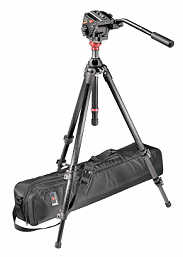 TRIPOD:
A tripod with a smooth fluid head that could hold a long telescopic lens that
was black and as small and light as possible at a fair price was the aluminum
Manfrotto-Bogen 3001BN plus their 501 quick release pro video head model 3433,
both for $222. at B&H or Woodland Hills Camera where I picked it up. The
25-inch bag is $33.95 at B&H; the Apron support 3146(166) $23. at Woodland
Hills Camera. The carbon fiber tripod 3444D lists for $522, or B&H=$369,
which is 4 times the price of the very similar aluminum 3001BN at $91.95 also
from B&H, all to save a few ounces: 3.5 vs. 3.9 pounds, and get slightly
less length: 19.2 vs. 20.9 inches; in any case half of the weight is in the
501 fluid head which weighs 3.4 pounds (List=$191, B&H=$135.); the 503 fluid
head model 3460 includes a 5.5 pound counter balance spring which is probably
nice but of unknown value, and offers no noticeable difference in smoothness
but costs almost double (List=$350, B&H=$247). It’s easy to spend
a lot more than the $222 spent here, for no additional benefits, or even $1000
to $4500 for a tripod that is big and heavy with no functional benefits unless
you have an old Mitchell 35mm motion picture camera with 1000-foot magazines,
along with a truck and an extra hour to set it up.
TRIPOD:
A tripod with a smooth fluid head that could hold a long telescopic lens that
was black and as small and light as possible at a fair price was the aluminum
Manfrotto-Bogen 3001BN plus their 501 quick release pro video head model 3433,
both for $222. at B&H or Woodland Hills Camera where I picked it up. The
25-inch bag is $33.95 at B&H; the Apron support 3146(166) $23. at Woodland
Hills Camera. The carbon fiber tripod 3444D lists for $522, or B&H=$369,
which is 4 times the price of the very similar aluminum 3001BN at $91.95 also
from B&H, all to save a few ounces: 3.5 vs. 3.9 pounds, and get slightly
less length: 19.2 vs. 20.9 inches; in any case half of the weight is in the
501 fluid head which weighs 3.4 pounds (List=$191, B&H=$135.); the 503 fluid
head model 3460 includes a 5.5 pound counter balance spring which is probably
nice but of unknown value, and offers no noticeable difference in smoothness
but costs almost double (List=$350, B&H=$247). It’s easy to spend
a lot more than the $222 spent here, for no additional benefits, or even $1000
to $4500 for a tripod that is big and heavy with no functional benefits unless
you have an old Mitchell 35mm motion picture camera with 1000-foot magazines,
along with a truck and an extra hour to set it up.
WRIST STRAP/GRIP: (research) Optech 1801021, B&H=$9.50 OPSCQDB; Voigtlander grip #45AD112A list=$55, B&H=$39.95 VOGBA;
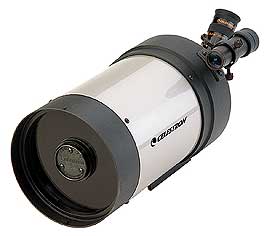 TELESCOPE:
For a long telescopic lens a 5-inch telescope may work very well for cameras
with removable lenses, and sometimes it may work well with various adapters
to fixed zoom lenses. The folded optics of the C5 also provide a much more compact
design than the refractors as well as several times more light gathering abilities
and a much lower price; and with Celestron’s .63 focal reducer the F:10
1250mm scope is converted to F:6.3 at 806mm; and with a 40mm eyepiece yields
about 20 X magnification and with a 10x zoom camera lens that should be extendable
to 200x. Although the optics of the camcorder and the telescope appear excellent,
unfortunately the JVC GR-HD1 zoom lens has adapted very poorly to a Celestron
C5 Spotting Telescope with several types of major optical problems. Celestron’s
F:10 1250 mm primary focal length appears greatly preferable to Meade’s
5 inch Spotting Scope with an F:15 1900mm focal length. If a wide aperture were
required Meade used to make an 8 inch F:6.3 LX200 Optical Tube for about $1000
in a 1250mm focal length into early 2003 (instead of the 2000mm F:10 Optical
Tube currently available), and with the Meade .33 focal reducer the F:6.3 tube
could provide an F:2 telephoto lens; unfortunately too few of these wide field
scopes were sold; also the .33 focal reducer could not be used with a camera
having a lens, so it requires a CCD or a removable lens camera. For terrestrial
video keeping the magnification down is a significant issue; since above 125
times magnification heat-wave patterns are clearly displayed. So the following
configuration was tested: a Celestron C5 Spotting Scope #11029, $569 at Woodland
Hills Camera and Telescopes 888-427-8766; plus a Celestron .63 Focal Reducer
#94175, $129 at WH Camera; plus the Scopetronics.com Maxview 40, 1.25 inch eyepiece
camera adapter 239-945-6763, $110. at WH Camera, which should yield a 20 to
200zoom range; plus a Step-Ring from T size which is approximately 42mm to the
JVC camera’s 52mm lens threads, $12.95 at WH Camera. Of course the telescope
and video camera assembly will require mounting to maintain alignment without
flexing, and provide a balanced tripod mount. So a flat aluminum bar about 18
inches long, 2 inches wide and 5/8 inches thick was used, with two .25 inch
holes drilled to mount the telescope at one end and at the other end a 1.75
inch square aluminum tube, 2+3/8 inches long to raise the video camera to the
telescope’s eyepiece height, which rests on the aluminum bar and supports
a camera plate 4.25 inches long, 2 inches wide, .25 inches thick; which has
one .25 inch hole for the camera mount plus 2 smaller holes to allow using 2
flat-head screws to the 1.75 inch spacer below it. The spacer can have a long
.25 inch slot at its bottom to allow sliding it back and forth while attached
to the 18 inch aluminum bar. When the system is satisfactorily optically aligned
and tested, the balance point of the 17 to 18 inch aluminum bar can be drilled
with a .25 inch hole and a stainless steel bolt used to attach the bar to the
tripod. Since this camera adaptation did not work optically and had problems
with sharpness, focus, a circular pattern at the right and left sides, image
distortions across the image plane, etc. A suggestion by Bill Turner at Century
was to consider trying a negative lens element from an optical company such
as Roland Optics. Alternatively a low light NTSC video CCD video camera may
be used on the scope’s eyepiece such as from: Supercircuits.com, 800-335-9777,
NTSC video camera: PC164C-EX ultra low-light level .0003 lux, 600 line resolution,
black and white, 250,920 pixels, C type lens mount, $180; plus a C mount to
1.25 inch telescope adapter (Oceanside $30); and using the JVC camcorder as
an NTSC recorder. Century Optics may offer an extended 4x telephoto option by
mid 2004 that may be adequate with a 4 to 40x zoom range, however a 10x telephoto
adapter with a 10 to 100x zoom range would be very useful if the optics were
adequately designed for 1 to 2 megapixel HDTV 720 to 1080 line progressive images.
Telescope eyepiece adapters utilized include: Celestron T-Adapter SC-93633-A
$36., T-Ring/T-Ring $20., Pentax 35mm camera to T-adapter, from Woodland Hills
Camera; Celestron CE-93636, T to C mount video adapter $30, from Oceanside Photo.
TELESCOPE:
For a long telescopic lens a 5-inch telescope may work very well for cameras
with removable lenses, and sometimes it may work well with various adapters
to fixed zoom lenses. The folded optics of the C5 also provide a much more compact
design than the refractors as well as several times more light gathering abilities
and a much lower price; and with Celestron’s .63 focal reducer the F:10
1250mm scope is converted to F:6.3 at 806mm; and with a 40mm eyepiece yields
about 20 X magnification and with a 10x zoom camera lens that should be extendable
to 200x. Although the optics of the camcorder and the telescope appear excellent,
unfortunately the JVC GR-HD1 zoom lens has adapted very poorly to a Celestron
C5 Spotting Telescope with several types of major optical problems. Celestron’s
F:10 1250 mm primary focal length appears greatly preferable to Meade’s
5 inch Spotting Scope with an F:15 1900mm focal length. If a wide aperture were
required Meade used to make an 8 inch F:6.3 LX200 Optical Tube for about $1000
in a 1250mm focal length into early 2003 (instead of the 2000mm F:10 Optical
Tube currently available), and with the Meade .33 focal reducer the F:6.3 tube
could provide an F:2 telephoto lens; unfortunately too few of these wide field
scopes were sold; also the .33 focal reducer could not be used with a camera
having a lens, so it requires a CCD or a removable lens camera. For terrestrial
video keeping the magnification down is a significant issue; since above 125
times magnification heat-wave patterns are clearly displayed. So the following
configuration was tested: a Celestron C5 Spotting Scope #11029, $569 at Woodland
Hills Camera and Telescopes 888-427-8766; plus a Celestron .63 Focal Reducer
#94175, $129 at WH Camera; plus the Scopetronics.com Maxview 40, 1.25 inch eyepiece
camera adapter 239-945-6763, $110. at WH Camera, which should yield a 20 to
200zoom range; plus a Step-Ring from T size which is approximately 42mm to the
JVC camera’s 52mm lens threads, $12.95 at WH Camera. Of course the telescope
and video camera assembly will require mounting to maintain alignment without
flexing, and provide a balanced tripod mount. So a flat aluminum bar about 18
inches long, 2 inches wide and 5/8 inches thick was used, with two .25 inch
holes drilled to mount the telescope at one end and at the other end a 1.75
inch square aluminum tube, 2+3/8 inches long to raise the video camera to the
telescope’s eyepiece height, which rests on the aluminum bar and supports
a camera plate 4.25 inches long, 2 inches wide, .25 inches thick; which has
one .25 inch hole for the camera mount plus 2 smaller holes to allow using 2
flat-head screws to the 1.75 inch spacer below it. The spacer can have a long
.25 inch slot at its bottom to allow sliding it back and forth while attached
to the 18 inch aluminum bar. When the system is satisfactorily optically aligned
and tested, the balance point of the 17 to 18 inch aluminum bar can be drilled
with a .25 inch hole and a stainless steel bolt used to attach the bar to the
tripod. Since this camera adaptation did not work optically and had problems
with sharpness, focus, a circular pattern at the right and left sides, image
distortions across the image plane, etc. A suggestion by Bill Turner at Century
was to consider trying a negative lens element from an optical company such
as Roland Optics. Alternatively a low light NTSC video CCD video camera may
be used on the scope’s eyepiece such as from: Supercircuits.com, 800-335-9777,
NTSC video camera: PC164C-EX ultra low-light level .0003 lux, 600 line resolution,
black and white, 250,920 pixels, C type lens mount, $180; plus a C mount to
1.25 inch telescope adapter (Oceanside $30); and using the JVC camcorder as
an NTSC recorder. Century Optics may offer an extended 4x telephoto option by
mid 2004 that may be adequate with a 4 to 40x zoom range, however a 10x telephoto
adapter with a 10 to 100x zoom range would be very useful if the optics were
adequately designed for 1 to 2 megapixel HDTV 720 to 1080 line progressive images.
Telescope eyepiece adapters utilized include: Celestron T-Adapter SC-93633-A
$36., T-Ring/T-Ring $20., Pentax 35mm camera to T-adapter, from Woodland Hills
Camera; Celestron CE-93636, T to C mount video adapter $30, from Oceanside Photo.
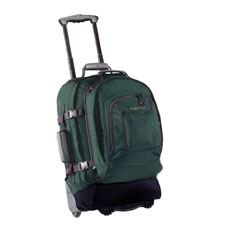 BAG:
For a camera bag; after the camera is fully configured with external microphones,
preamplifiers, optics, etc. I understand that Sony is going to be marketing
an equipment bag that’s more impact resistant; see EVS. However standard
camera and equipment bags use handles for carrying, and since this is not a
pocket size camera, which is unfortunate, when you add the weight of the additional
and significant improvements to sound, optics, batteries, tapes, charger, tools,
etc. the weight is significant, and becomes difficult to carry in conventional
bags for more than very short distances. So if you ever travel or just walk
a few city blocks then backpacks and bags with wheels are very helpful, such
as Eagle Creek's Switchback Modular 22, (14 by 22 by 9 inch, 7 pounds 13 ounces)
which is a backpack which also has wheels and an extendable handle, lists for
$250., can be used as aircraft carry-on luggage, has removable components, and
an add-on Flight-bag option which goes on the handle and lists for $100. (See:
www.eaglecreek.com 800-874-1048, and www.rei.com 800-426-4840; A16 and others.)
Of course foam and clothing can be added to any bag to improve impact resistance.
Wal-Mart also has a 20 inch bag by Ozark Trail with handles, a shoulder strap,
and an approximately 18 inch internal compartment for $9.82; that by simply
adding a 2 inch thick foam bottom and towels on the 2 sides and top makes a
useful solution for short carrying distances, perhaps with far better impact
resistance than $200 professional camera bags, as well as a less costly appearance,
in case that's an issue. Also one of the more useful camera covers is an oversized
plastic bag from a grocery or health food store, since its compact, easily removed,
provides rain or dust protection, and can be quickly stored in a pocket.
BAG:
For a camera bag; after the camera is fully configured with external microphones,
preamplifiers, optics, etc. I understand that Sony is going to be marketing
an equipment bag that’s more impact resistant; see EVS. However standard
camera and equipment bags use handles for carrying, and since this is not a
pocket size camera, which is unfortunate, when you add the weight of the additional
and significant improvements to sound, optics, batteries, tapes, charger, tools,
etc. the weight is significant, and becomes difficult to carry in conventional
bags for more than very short distances. So if you ever travel or just walk
a few city blocks then backpacks and bags with wheels are very helpful, such
as Eagle Creek's Switchback Modular 22, (14 by 22 by 9 inch, 7 pounds 13 ounces)
which is a backpack which also has wheels and an extendable handle, lists for
$250., can be used as aircraft carry-on luggage, has removable components, and
an add-on Flight-bag option which goes on the handle and lists for $100. (See:
www.eaglecreek.com 800-874-1048, and www.rei.com 800-426-4840; A16 and others.)
Of course foam and clothing can be added to any bag to improve impact resistance.
Wal-Mart also has a 20 inch bag by Ozark Trail with handles, a shoulder strap,
and an approximately 18 inch internal compartment for $9.82; that by simply
adding a 2 inch thick foam bottom and towels on the 2 sides and top makes a
useful solution for short carrying distances, perhaps with far better impact
resistance than $200 professional camera bags, as well as a less costly appearance,
in case that's an issue. Also one of the more useful camera covers is an oversized
plastic bag from a grocery or health food store, since its compact, easily removed,
provides rain or dust protection, and can be quickly stored in a pocket.
CHROMAKEY BLUE SCREEN: J&K 800-476-3864, M-F 4pm Texas, DAL 46-10 Blue = 11 by 15 foot = $169.99 with 2 stands.
VIDEO TAPE: So far I'm buying standard 6 packs of TDK mini-DV cassettes (cobalt-evaporated formulation) at Costco for about $28.
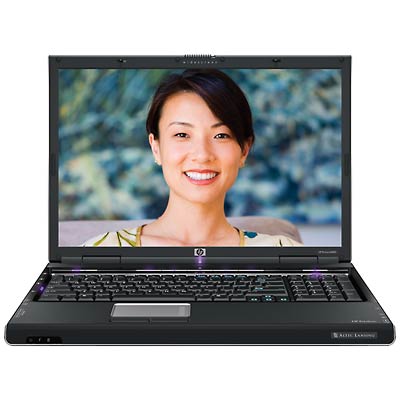 EDITING:
I will probably not be editing in JVC’s MPEG Edit Studio or any
of several other HDV editing systems, which may provide compression and image
resolution losses when creating optical effects. I'll probably use Adobe Premier
Pro 2, which only runs on Windows XP, with Adobe After Effects in the Cine Form
Aspect HDV format 720p or 1080i, see: cineform.com, which provides loss-free
compression and high-speed performance; and a few other HDV software tools;
on a Pentium 4, 915 or 925 chip which is designed to process high-definition
video, using the 3.4 GHz HP Pavilion zd8000 notebook with 2 gigabytes of RAM
and a 100 GB 7200 RPM hard drive (preferably with a dual or quad core/CPU if
it were available), with a high-definition 1680 by 1050 display, (preferably
a 1200 by 1920 video display if it were available with the faster processors);
and an ATI graphic processor X600 with two 3-D pipelines, (however preferably
with the V5000 ATI display processor which has six 3-D pipelines but is not
available with the faster pentium 4's); using external 1394 FireWire 800 hard-drives,
which transfer data at 800 megabits per second from LaCie.com with a one terabyte
RAID 0 or 1 drive from Maxtor at 7200 rpm with 16 MB buffers, using a LaCie
PCMCIA interface card, which performs better for video than the internal drives
according to Cine Form’s tests; and according to the specifications FireWire
800 external drives are in fact faster than internal ATA drives; which makes
the need for internal RAID hard-drive configurations unnecessary, and which
yields a big heavy immobile editing machine, that is considerably more costly
than this already available laptop computer. Purchased from costco.com for about:
$2680.34 with most options selected and including shipping. Incidentally this
HP Pavilion zd8000 is fully capable of editing multiple streams of full HD 1920
by 1080 progressive video with Cine Form Prospect, which is just at the beginning
of being able to provide theatrical motion picture quality. No doubt the more
religiously adherent desktop computer adherents will resent the fact anyone
would have the nerve to edit video, even worse HDV, on a notebook computer with
an excellent HD screen, after I've been repeatedly warned that this couldn't
possibly work; and on a system that in total costs less than half the price
of their huge Apple or RAID systems, and I'm getting better multi-stream HDTV
performance on the notebook along with the personal freedom of traveling and
working anywhere. Since this laptop is on the heavy side a sturdy backpack is
a comfortable way to carry the computer, power supply and accessories. NOTE:
HP's newer lighter dv8000t series 2.16 GHz Intel dual core notebook provides
2 low power consuming processors that are equivalent to two Pentium 4, 3.2 GHz
processors due to more advanced instruction preprocessing; and so should make
the unit clearly preferable when they decide to install two 7200 RPM drives
instead of their custom packaged 5400 RPM drives now available; which also means
that these drives probably can't be replaced with standard 2.5 inch internal
drives. Pricing is about $2300 fot the complete high-definition dual processor,
dual hard drive notebook system, plus the price of the Adobe Premier Pro 2 newly
integrated video editing collection (Creative Suite Production Studio Premium,
and the Adobe Video Bundle, about $2100 list, with educational pricing of $650
and $800 with Flash).
EDITING:
I will probably not be editing in JVC’s MPEG Edit Studio or any
of several other HDV editing systems, which may provide compression and image
resolution losses when creating optical effects. I'll probably use Adobe Premier
Pro 2, which only runs on Windows XP, with Adobe After Effects in the Cine Form
Aspect HDV format 720p or 1080i, see: cineform.com, which provides loss-free
compression and high-speed performance; and a few other HDV software tools;
on a Pentium 4, 915 or 925 chip which is designed to process high-definition
video, using the 3.4 GHz HP Pavilion zd8000 notebook with 2 gigabytes of RAM
and a 100 GB 7200 RPM hard drive (preferably with a dual or quad core/CPU if
it were available), with a high-definition 1680 by 1050 display, (preferably
a 1200 by 1920 video display if it were available with the faster processors);
and an ATI graphic processor X600 with two 3-D pipelines, (however preferably
with the V5000 ATI display processor which has six 3-D pipelines but is not
available with the faster pentium 4's); using external 1394 FireWire 800 hard-drives,
which transfer data at 800 megabits per second from LaCie.com with a one terabyte
RAID 0 or 1 drive from Maxtor at 7200 rpm with 16 MB buffers, using a LaCie
PCMCIA interface card, which performs better for video than the internal drives
according to Cine Form’s tests; and according to the specifications FireWire
800 external drives are in fact faster than internal ATA drives; which makes
the need for internal RAID hard-drive configurations unnecessary, and which
yields a big heavy immobile editing machine, that is considerably more costly
than this already available laptop computer. Purchased from costco.com for about:
$2680.34 with most options selected and including shipping. Incidentally this
HP Pavilion zd8000 is fully capable of editing multiple streams of full HD 1920
by 1080 progressive video with Cine Form Prospect, which is just at the beginning
of being able to provide theatrical motion picture quality. No doubt the more
religiously adherent desktop computer adherents will resent the fact anyone
would have the nerve to edit video, even worse HDV, on a notebook computer with
an excellent HD screen, after I've been repeatedly warned that this couldn't
possibly work; and on a system that in total costs less than half the price
of their huge Apple or RAID systems, and I'm getting better multi-stream HDTV
performance on the notebook along with the personal freedom of traveling and
working anywhere. Since this laptop is on the heavy side a sturdy backpack is
a comfortable way to carry the computer, power supply and accessories. NOTE:
HP's newer lighter dv8000t series 2.16 GHz Intel dual core notebook provides
2 low power consuming processors that are equivalent to two Pentium 4, 3.2 GHz
processors due to more advanced instruction preprocessing; and so should make
the unit clearly preferable when they decide to install two 7200 RPM drives
instead of their custom packaged 5400 RPM drives now available; which also means
that these drives probably can't be replaced with standard 2.5 inch internal
drives. Pricing is about $2300 fot the complete high-definition dual processor,
dual hard drive notebook system, plus the price of the Adobe Premier Pro 2 newly
integrated video editing collection (Creative Suite Production Studio Premium,
and the Adobe Video Bundle, about $2100 list, with educational pricing of $650
and $800 with Flash).
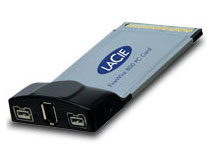
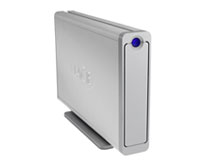

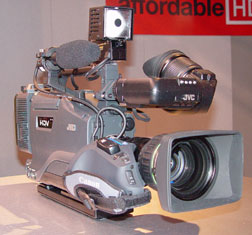 SUMMARY
COMMENTS: Incidentally the JVC GR-HD1 is better than expected,
although I agree with most user’s suggestions for improvement; however
there is little reason to get the supposedly more pro version, the JY-HD10 since
the XLR connectors don’t have phantom power and you have to put on something
like a BeachTek anyway; also the shotgun mic in the advertising photos is a
low-end Azden which is not included; however while the lowered edge enhancement
in the JY-HD10 may be desirable, perhaps adjustments in editing software effects
packages may resolve a slight unsharpening if needed anyway; so there is probably
nothing to gain with the $4000 JVC camcorder that’s supposed to be more
professional. The options I would pay extra for would be the 1080 by 1920 progressive
HDTV format, and a much smaller package (like the palm sized Sony IP-5) with
2 built-in wireless mic receivers and a removable lens. Actually it would be
great if the lens with the CCD could be separated from the display and the recording
mechanism (which would go in a pocket; while the lens with the CCD would be
clipped to ones clothing, cap or be hand-held). The 1080 "interlaced"
formats now being promoted by Sony, Panasonic and Canon are apparently a step
backwards. Nevertheless the 30 fps standards are just fine and preferable to
the archaic 1920’s 24 fps movie projection standard. If you have $1 per
frame to convert your video to 35mm film you could still convert it from 30
fps; however it also might just be less costly to buy a used Arriflex and get
a far better image, or just wait for HDTV projectors to arrive at local theatres.
While JVC’s 720p is much better than NTSC or PAL video, it’s just
about equal to 16mm movie film, and 1080p is almost exactly equal to Super 16mm
movies. 35mm motion picture film records about the equivalent of JVC’s
experimental Quad-HD, which is around 2160 by 3840, or about 8 megapixels per
frame; of course there are losses in 35mm motion picture transfers and mechanical
projector vibrations that may allow only 3-4 megapixels to get onto the theatre
screen; so the 2.1 megapixel 1080 progressive at 30fps is a real minimum for
barely acceptable image quality, as demonstrated in the 2002 Star Wars Episode
shot in 1080p with Sony electronics inside a PanaVision camera, supposedly to
get slightly better optics; which was like shooting a big budget feature movie
on 16mm film. While that may make no sense, unfortunately what makes even less
sense is that Sony is no doubt trying to keep any such 1080p (16mm equivalent)
cameras out of your hands. Sony should actually be working on Quad-HD with JVC
for the movie industry and begin cranking-out the full 2.1 megapixel 1080p cameras
for the low-end amateur video market along with an affordable (not huge) flat
1080p display; perhaps like Apple’s $1995 HD display with IEEE-1394, USB-2
and HDTV interfaces.
SUMMARY
COMMENTS: Incidentally the JVC GR-HD1 is better than expected,
although I agree with most user’s suggestions for improvement; however
there is little reason to get the supposedly more pro version, the JY-HD10 since
the XLR connectors don’t have phantom power and you have to put on something
like a BeachTek anyway; also the shotgun mic in the advertising photos is a
low-end Azden which is not included; however while the lowered edge enhancement
in the JY-HD10 may be desirable, perhaps adjustments in editing software effects
packages may resolve a slight unsharpening if needed anyway; so there is probably
nothing to gain with the $4000 JVC camcorder that’s supposed to be more
professional. The options I would pay extra for would be the 1080 by 1920 progressive
HDTV format, and a much smaller package (like the palm sized Sony IP-5) with
2 built-in wireless mic receivers and a removable lens. Actually it would be
great if the lens with the CCD could be separated from the display and the recording
mechanism (which would go in a pocket; while the lens with the CCD would be
clipped to ones clothing, cap or be hand-held). The 1080 "interlaced"
formats now being promoted by Sony, Panasonic and Canon are apparently a step
backwards. Nevertheless the 30 fps standards are just fine and preferable to
the archaic 1920’s 24 fps movie projection standard. If you have $1 per
frame to convert your video to 35mm film you could still convert it from 30
fps; however it also might just be less costly to buy a used Arriflex and get
a far better image, or just wait for HDTV projectors to arrive at local theatres.
While JVC’s 720p is much better than NTSC or PAL video, it’s just
about equal to 16mm movie film, and 1080p is almost exactly equal to Super 16mm
movies. 35mm motion picture film records about the equivalent of JVC’s
experimental Quad-HD, which is around 2160 by 3840, or about 8 megapixels per
frame; of course there are losses in 35mm motion picture transfers and mechanical
projector vibrations that may allow only 3-4 megapixels to get onto the theatre
screen; so the 2.1 megapixel 1080 progressive at 30fps is a real minimum for
barely acceptable image quality, as demonstrated in the 2002 Star Wars Episode
shot in 1080p with Sony electronics inside a PanaVision camera, supposedly to
get slightly better optics; which was like shooting a big budget feature movie
on 16mm film. While that may make no sense, unfortunately what makes even less
sense is that Sony is no doubt trying to keep any such 1080p (16mm equivalent)
cameras out of your hands. Sony should actually be working on Quad-HD with JVC
for the movie industry and begin cranking-out the full 2.1 megapixel 1080p cameras
for the low-end amateur video market along with an affordable (not huge) flat
1080p display; perhaps like Apple’s $1995 HD display with IEEE-1394, USB-2
and HDTV interfaces.
HDV Camcorder Design Improvements: Apparently almost all industrial designers or marketing departments never use the products they design; and those who use the products in productive ways rarely have time to create factories, or even think about the problems they are having; which leaves a lot of room for improvements in any endeavor, such as video recording and help make it a better way to document events or our lives, which can be more interesting and relevant than anything at the movies.
Since there are already many manufacturers of portable hard-drives, lenses, microphones, camera chips and portable computers. The only thing a camera manufacturer needs to create is a chip holder with a lens mount, along with a IEEE1394 adapter cable, say 4 feet long with electronics at or near the 1394 (or USB-2) connector end; which of course would need to include MPEG-2 or 4 conversion for a minimum of a 1080 by 1920 resolution color chip and 16-24 bit stereo audio stream; along with plugs for a wearable viewfinder and stereo audio monitoring. So every component in the system could be readily upgraded as advances occur, or as needed to resolve wear and damages; as well as not be packaged in the bulky and clumsy box that's typical of camcorders. More significantly such a design could make high-definition recording a non-intrusive part of life, that could help document educational experiences that may be made available to others through the Internet, or even help reduce injustices, abuse and violence through documentation; as well as provide an alternative to the social propaganda and indoctrination that's typical in any mass consumer driven media, that in many significant areas deprives its audience of knowledge and personal benefits.
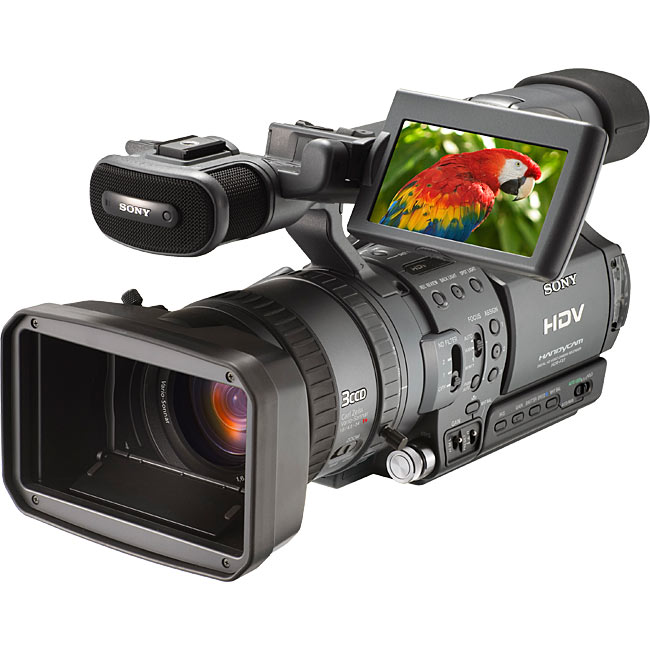 Sony
intentionally sabotages the high-definition video standard in two ways with
its HDR-FX1 HDV Camcorder. 1st it installs a 1 mega pixel CCD chips that records
only 960 horizontal pixels, instead of 1920 horizontal pixels which is the defined
standard, which is exactly half the minimum pixel count. So on playback Sony
then creates 2 pixels for every pixel it recorded in order to produce an irreparably
degraded image. Sony has no shortage of high-definition imaging chips since
it has been putting 3.3 megapixel CCD chips in its amateur video cameras for
many years, which might be excellent for any high-definition camera. 2nd Sony
interlaces half of the pixels on each frame with half the pixels from the previous
frame, to further degrade the image, which also impedes many kinds of digital
image processing. Again this is another irreparable degradation to what Sony
calls its high-definition format. Sony also claims that their chip design makes
them promote interlaced scanning; but if you look at the specifications for
Sony's CCD chips you notice that progressive scan is an option; so then why
not at least make that option selectable by the user and not imposed by the
manufacturer, particularly when HDTV allows for progressive scan, which is being
provided on all DVD players as a standard.
Sony
intentionally sabotages the high-definition video standard in two ways with
its HDR-FX1 HDV Camcorder. 1st it installs a 1 mega pixel CCD chips that records
only 960 horizontal pixels, instead of 1920 horizontal pixels which is the defined
standard, which is exactly half the minimum pixel count. So on playback Sony
then creates 2 pixels for every pixel it recorded in order to produce an irreparably
degraded image. Sony has no shortage of high-definition imaging chips since
it has been putting 3.3 megapixel CCD chips in its amateur video cameras for
many years, which might be excellent for any high-definition camera. 2nd Sony
interlaces half of the pixels on each frame with half the pixels from the previous
frame, to further degrade the image, which also impedes many kinds of digital
image processing. Again this is another irreparable degradation to what Sony
calls its high-definition format. Sony also claims that their chip design makes
them promote interlaced scanning; but if you look at the specifications for
Sony's CCD chips you notice that progressive scan is an option; so then why
not at least make that option selectable by the user and not imposed by the
manufacturer, particularly when HDTV allows for progressive scan, which is being
provided on all DVD players as a standard.
Sony's effort to sabotage affordable high-definition video has two purposes: 1st to keep higher quality real high-definition video out of the hands of documentary and low-budget filmmakers who might otherwise be able to make movies that are competitive with high-budget studios, or worse yet allow any filmmaker the possibility of saying something that could be relevant; which somehow might be encouraged by offering the standard 1080p format, that Sony sells to professional moviemakers and television networks. If progressive scan was inferior to interlace as Sony tells the amateurs, then why does Sony sell all its progressive scan cameras to professional filmmakers who want the best image they can get on tape, and technically know the difference? The 2nd reason is that Sony doesn't want a $3000 camera competing with cameras they sell for $200,000. So Sony has provided a junk HDV format to the amateurs for well over $9000 with all the various needed optical and audio accessories, along with editing capabilities.
In every other respect Sony apparently did a good job with their FX1 in terms of controls and color rendition; and the FX1 produces a better video image than the JVC GR-HD1; which would be expected with 3 CCD's. However with all the other issues and serious FX1 shortcomings it would be better to avoid Sony's interlaced format inherit to the FX1, which will not be compatible throughout the editing process with any real high-definition progressive video whether it's from Sony's own professional equipment, the JVC GR-HD1 which is progressive, or anything else more reasonable that might come out from Canon, Panasonic or JVC. Further the process of converting between interlaced and progressive is complex, time-consuming, costly and degrading. After a review by the U.S. military it was determined that the 720 by 1280 format (720p) which is what's available on the JVC GR-HD1, is the optically superior and clearer imaging format, and is better than any 1080 by 1920 image that has been interlaced (1080i), with all other factors being equal. Well the full 1080i format is actually not providing one 2 megapixel image per frame but two 1 megapixel images every 1/60 second that are oscillating between odd and even lines that are sort-of combined into one image; while 720p just gives a full 1 megapixel frame every 1/30 second, without the fine detail jitter of 1080i. Of course Sony's FX1 doesn't even provide a 2 megapixel frame, but degrades the format to half of its resolution, by providing two 1/2 megapixel frames that jitter every 1/60 second to produce an illusion of a 1 megapixel frame; which means Sony does not provide a better format than JVC's 720p, because it does not provide more information or more pixels, and the pixels that they do provide are jittering between odd and even scan lines, which is not good for recording the details of a scene; which is the whole point of high-definition.
While the Sony HDV produces a better image, the difference between the JVC 720p is not great and consequently, it is worth waiting for someone to make a significantly better HD camera, preferably providing for 1920 by 1080 progressive recording, with a removable lens and a small camera head which is separate from the recording unit; instead of lumping it altogether as a camcorder. Which incidentally does not mean less integration or less automation; that aspect of technology should increase considerably and improve in audio quality and wireless integration. However it needs to be done less obtrusively.
The appropriate thing may appear to be to wait for a 2 megapixel, 1080 by 1920, 30 frame per second progressive scan camera to come out, preferably with a removable lens; and in the mean time stay with the JVC GR-HD1; perhaps buy a used one from eBay with little use below 1/2 price; or if you don't need lip sync sound perhaps buy a used pin-registered 35 mm Arriflex for around $3,000 and have the film scanned at 2, 4 or even 8 megapixels per frame and begin editing really high-definition images that Sony probably won't be making available in the next 50 to 100 years. Of course most of the same components and accessories reviewed here would be relevant for any high-definition configuration.
Another not insignificant issue is that the Sony FX1 is physically a huge camera; and compared the JVC GR-HD1 it's about double the size; and I find that the JVC is already way too big. So if Sony and JVC can make a palm sized PAL/NTSC DV format camera with a 3 megapixel CCD imaging chip, then there's no reason that size camera couldn't record in high-definition. However there seems to be less intentional hostility against high-definition video standards at JVC than at Sony's marketing division; in fact JVC has already designed a 1080 by 1920 progressive scan camera using 3 Rockwell CCD chips, to sell for $20,000. If JVC could put just 1 Rockwell 1080 by 1920 chip with a color mask into their GR-HD1 and sell it for the same price as Sony's fake HDV, and provide 30 fps output along with a 24 fps option for those "filmmakers" who want to introduce a flickering "movie-look" into their video, then JVC could easily take over the potentially huge high-definition video market, while Sony stubbornly sticks to their interlaced video in order to degrade HDV. Obviously the availability of low cost high-definition video equipment isn't going to open the doors to competition with the studios, the television networks and movie stars when it comes to motion picture productions; because the new and vital filmmakers are not just lacking equipment but ideas, visual perception, ability to understand geopolitics, ecology, human psychology, biology and are clearly unable to undo the decades of misinformation experienced over decades; so new filmmakers regardless of cultural background will offer extremely little to no competition to the established regimes or corporate interests, since they clearly don't even see what the alternatives are, and will be unable to deduce them in less than 1/2 a century of study, which is an unlikely prospect; which if it could occur would only make such information appear as impossible and so irrelevant. Nevertheless independent motion pictures can communicate critical life issues and become the news and educational media of the future.
February 2005
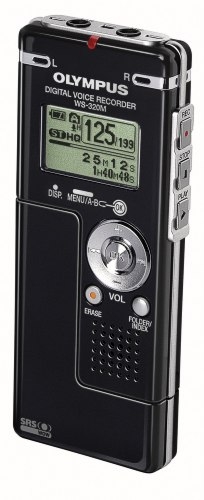
This may be the best small recorder available, with high quality stereo and mono recording capabilities. This recorder could be used as a 2nd audio unit if you’re shooting a documentary by just leaving it on all day in a shirt pocket of the film’s subject, since it records about 8-10 hours with 1 AAA battery, and can hold 71 hours of High Quality recordings. Perhaps the Apple iPods won’t offer a stereo mic option because they’re afraid it would be used to record live music events; perhaps even worse of friends and groups that are not mass marketed; that would then be freely and legally traded. Well apparently this tiny Olympus can do a good job at high quality stereo recording, and you could still use it to play back tons of Windows Media Audio or MP3 songs.
For voice, information and notes I might just use the internal mics on this Olympus WS-320m recorder. I also recorded from a pair of my AKG studio mics CK93+SE300B with a BeachTek DXA-8 amp, which indeed recorded a full sound spectrum. However with such a pre-amp set the Olympus “Mic Sense” to “Dict” mode; but don’t use “Conf” (high-sensitivity) mode or it will distort.
If you’re recording speech with the internal mics of someone in a room then definitely do set the Mic Sense option to “Conf” for higher sensitivity. If you’re recording from a telephone using the Olympus TP-7 mic, the clarity is best by setting Mic Sense to “Dict” to avoid distortion, since this external mic set-up is too sensitive; and naturally record in Mono HQ when there is only 1 mic involved, or when 1 mic is adequate for the job which may be typical. However recording in stereo HQ mode in an open room did sound a little better, even with the tiny internal mic separation.
The Olympus ME-15 lavaliere mic clearly provides a stronger signal and better recording than the internal mics, something I didn’t expect; which is clearly shown on the recorder's amplitude meter, which jumps from about 15% to over 50% with the Olympus tie clip mic. So for up-close high-quality recording set the recorder’s sensitivity to low (or Dict mode) and if the speaker is always over a couple of feet away set it to high sensitivity (or Conf mode), and generally avoid the internal mics and stay in HQ mono. Also Sony makes a smaller clip-on lavalier mic ECM-C10 (about $27) and stereo mics ECM-719 (about $75), or ECM-MS907; however these have cords which may get in the way in some situations.
The Olympus External Stereo Microphone ME-51s ($60 list) may be a better alternative
to using the internal mics altogether or the lavaliere, (it should produce a
strong clear signal, as the specifications indicate). Further it doesn’t
have the problem of dealing with the lavelier’s wire, which is generally
unnecessary with such a small device.
If you plug in a Sennheiser ME-2 lavaliere (about $125) this recorder’s quality does improve a little in the highs and crispness over the Olympus lavaliere ME-15 (about $25) which is also very good. However you may well have a tiny professional recording system with a Sennheiser mic. Both the Sennheiser and Olympus lavalieres produce about the same signal strength. I understand from Sennheiser that some Broadway shows may opt to use the MKE2-EW omni lavaliere (list $350) with their UHF transmitters, or the MEK104 or MEK105 for directionality; or if size isn’t an issue the ME-66 + K6 shotgun microphone. However I gather that going beyond the ME-2 is getting into fairly subtle acoustic issues that few would ever notice.
Since the recorder is so miniature, a small cell phone case that has a belt loop provides plenty of space for the device, its external mic and extra batteries. (Home Depot, $5)
Are there any problems with this exceptionally useful recorder? Absolutely, and they’re all related to the controls, and they’re fairly problematic.
For example why would I ever need to look at a recorder to turn it on, to pause or stop? Consider that you have your little recorder in your pocket one day and unexpectedly somebody begins threatening your life, or sabotaging your company through lies, intimidation and slander. Why wouldn’t you record such abusive or life threatening behavior being made by a thug? Even if it’s against the law to document an assault, we also know that such evidence is regularly used in courts; where as we also know that the truth rarely gets a hearing, and justice is never the purpose. Now would I ask an assailant for a ½ minute while I turn-on my recorder; which he will then be certain to take with him after the murder; or do I simply slide one switch all the way up, so that I am fairly certain that it’s recording without ever looking at the recorder? Why is this such a complicated question for any company that makes all kinds of audio and video recorders, to even consider? It’s like the designers have never used the devices they design, or are massively incompetent, and management absolutely doesn’t care. Ok, what might such simple controls look like on a recorder?
Yes this is a great machine and definitely worth buying with external mics (ME-51s and TP-7). Amazon is also very good, and Olympus for accessories (800-201-7766, m-f, 9-5pm est). But it would certainly be helpful if Olympus could evaluate the control suggestions for the future; so I could buy their 32 GB audio/HD video MPEG-4 version, with a tiny plug-in, clip-on HD pickup head, in some upcoming release. Incidentally, less than 10% of the world’s knowledge has ever been documented; such a tiny recorder could help preserve some very useful knowledge that would otherwise be lost forever.
zyxazyx, May 2006
Video and optical sources:
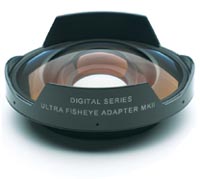
Telescopes, adapters and cameras:
Lighting, chromakey, batteries and bags:
Video editing and special effects software:
Sound recording accessories and microphones:
Small rechargeable batteries:
GPS street and topography maps:
(Configured JVC GR-HD1, select image to enlarge)
Camera configuration images
© bgc, 13-10-45-71+268:foen, web site created November 2003, last updated: Monday, May 15, 2006 1:33 PM